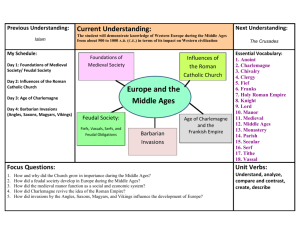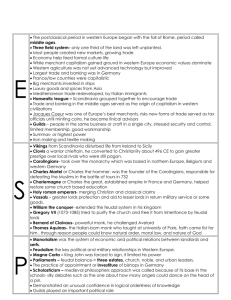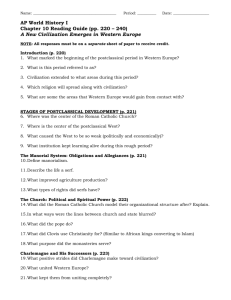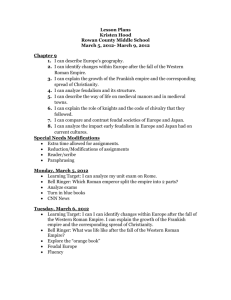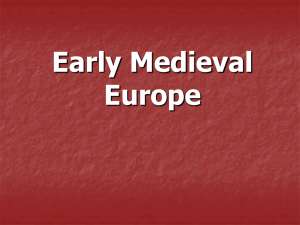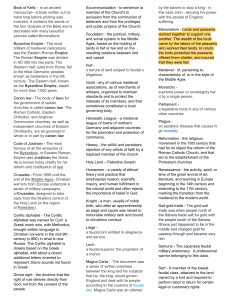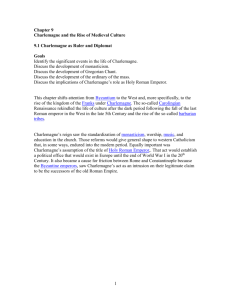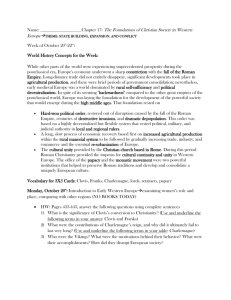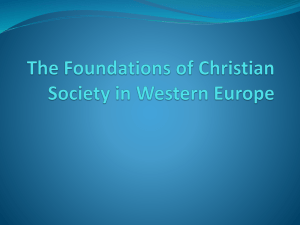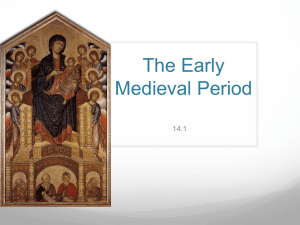Western Europe 600 - 1450 C.E. - Yola
advertisement
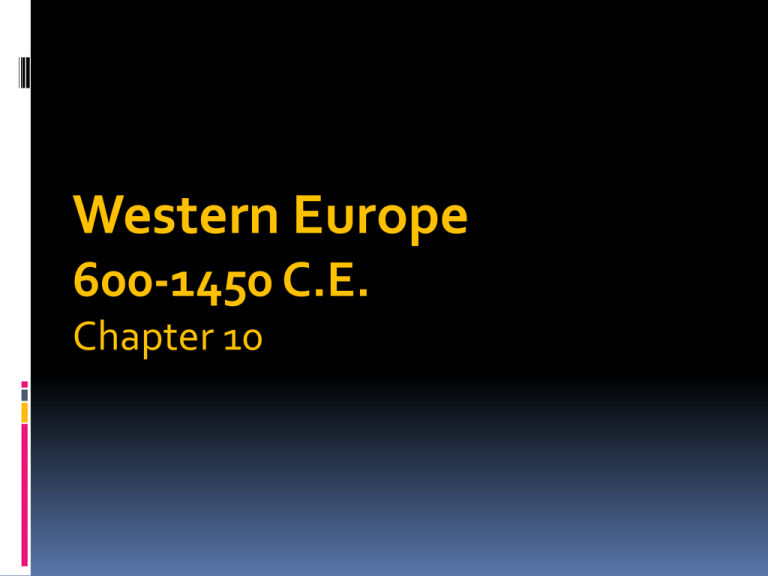
Western Europe 600-1450 C.E. Chapter 10 Western Europe’s Timeline Charlemagne’s Empire and Successor States Western Europe towards the End of the Middle Ages Stages of Postclassical Development Europe’s Postclassical Era = Middle (Medieval) Ages 476-1453 CE Political Fragmentation prevails Catholic church in Rome remained strong, but Italy divided politically Arab Muslims invaded Iberian Peninsula (Spain) Core of postclassical West: France, Low Countries, Germany Later, England where civilization, in human organization was new Scandinavian “Vikings” Raids from 8th to 10th centuries Showed Europe’s weakness Disrupted life from Ireland to Sicily! Literacy declines except among churchmen & the hierarchy Politics, Economics, & Culture The Manorial System Created an oppressive system that described economic and political relations between landlords and their peasant laborers Originated: Later Roman Empire Decline Agricultural economy Serfs- were agricultural laborers under the jurisdiction of aristocratic landowners farm work for protection, justice from landlords (Not Slaves, Not for Sale) Reciprocal obligations tied to the land In-kind labor for produce 800s agricultural innovation gradually improved with a technological innovation: Moldboard- better plow, curved metal plate = deeper turning of the soil Three Field system of Crop rotation Added acres to production by leaving only a third of the land unplanted, plants rotated to strengthen soil. In the old two-field system half the land was sown to crop and half left unplanted each season Religion The Church: Political and Spiritual Power Most organized institution in western Europe Popes follow Roman organization Regulated doctrine (heresy) Regional Appointed bishops Appointed local priests Sponsor missionaries Established chain of monasteries Benedict of Nursia, founder of Western Christian monasticism (480-547) Benedictine rule- help unify western Europe Spiritual functions Holiness, Network, Pilgrimage centers , Secular functions, Education, Large estates, Shelter travelers, & Universities from 13th century Clovis’s conversion to Christianity in 496, helped him gain power and unified the Franks (Germanic Tribe in France) Religion & Political Power Frankish Carolingian dynasty Enormous empire in France & Germany 1st to use the imperial title “Holy Roman Empire” Charles Martel (Charles the Hammer) Defeated the Muslims, Battle of Tours, 732 Contained Muslims in Spain Charles the Great (Charlemagne) Dec. 25, 800, crowned emperor (Holy Roman Empire) Copied Roman central administration After his 814 death the empire does not survive his death 843, Treaty of Verdun = Three kingdoms Europe fragments into regional monarchies No single language or government could unify Europe (Latin of the church) Holy Roman emperors = hollow empire Ruled Germany, Italy, but couldn’t control local lords, which would lead later to states Economics and Culture New Economic and Urban Vigor after 900 Agricultural Techniques From contact with Eastern Europe and Asian raiders into central Europe Moldboard plow & 3 field system New horse collar that allowed horses to be yoked w/out choking Increased production Towns grow Cultural liveliness (People are fed & settled) Literacy expands (Charlemagne 9th cent) Surplus wealth – architecture & Medieval Art Education Cathedral schools, from 11th century Italy, universities in medicine (Muslims & Greek Science), law, (Revival of Roman Law) Universities, from 12th century Oxford & Cambridge follow Parisian example Feudal Monarchies & Political Advances Key military & political system in the Middle Ages was feudalism Land ownership & military power Vassals -Military Elite, service for land Political stability & improved agriculture promoted population growth & economic innovation & land expansion 10-13 centuries Some lords emerge more powerful Provided protection & aid to vassals (lesser lords) Horse collar & stirrups helped military dominance who used horses for combat End of 10th century, Viking raids tapered off regional governments stronger Some Viking groups Christianized & Assimilated into the culture Ex. French Normandy Capetian kings of France Feudalism developed bureaucracies, states slowly until kingship Feudalism grows quickly in England William the Conqueror (Viking descent) 1066, Norman conquest of England Introduced feudal monarchy abruptly Centralized government Sheriffs, standardized law, & courts Feudal monarchy unknowingly copied earlier centralizing societies like China Limited Government Political fragmentation continues throughout West Europe Monarchs limited by church, nobles, towns State not suppose to intrude on matters of faith Carried out orders from the Pope, or Bishops 1215, Magna Carta King John recognizes supremacy of written law Representative bodies/ parliaments serve as further checks on royal authority Differed from Japanese Feudal system based on loyalty – Europe developed early checks & Balances 1st parliament England 1265 Kingdom of Catalonia from 1000 3 Estates= Church, Nobles, urban leaders Monarchs continued to increase in power Small local conflicts became Large conflicts Hundred Years’ War 1337-1453 English lands in France Joan of Arc 1412-1431 Expansionist Spurred by Population Growth? Germanic knights From 11th century onward, into eastern Germany, Poland Iberia (Spain) Northern Christian states (forces) begin reconquista Full Expulsion occurred 1492 Spain united under the marriage of Ferdinand & Isabella Vikings Cross Atlantic, Iceland, Greenland, America Crusades (1095-1291) (Super Power? Nope) Called by Pope Urban II Crusaders were promised full forgiveness sins if they died in battle Attracted to winning spoils from rich Arab lands Initial successes (Controlled Jerusalem about 100 years) Ended in defeat (Esp. by Saladin in 1187) New contact with Islam, but no contact with N. Africa until after the start of Exploration (Prince Henry the Navigator) Exposed to new culture & economics New possibilities in trade Religious Reform and Evolution Gregory VII Gregorian reform, 11th century Based in monasteries Investiture controversy- most significant conflict between Church and state in medieval Europe. Stop the state or, Holy Roman Emperor (Henry IV) from appointing bishops in Germany Separation of secular and religious spheres Reforming monastic orders founded in Assisi in the 13th century, Mendicants St. Dominic - Dominicans = Friars Vow poverty, chastity & obedience in service to a community St. France - Franciscans – Poverty/Service Women’s version- St. Clare’s Order of Saint Clare Key tensions- Great Schism (Western) (1378-1417) Two rival popes College of Cardinals in Rome & Avignon, France (**Note: Three Popes) Religious Reform & Evolution Theology: Assimilating Faith and Reason Exploration of Greek philosophy assimilated into Catholic religious tradition: Aristotle was known as the philosopher during Charlemagne’s time! (Aristotelian) Peter Abelard, 12th century Wrote: “Yes and No” a rational/logical examination of church doctrine Bernard of Clairvaux, Monk, opposed to Abelard's approach, Mysticism (Mystical union vs. rational) That rational reason was dangerous Stressed the importance of mystical union with God, •Roger Bacon- 1220blissful glimpses & Faith 1292 Led to debates in universities (Scholasticism) • Oxford, scientific By 13th century, Philosopher-theologians emerged experiments on armed with Greek Philosophy & Science, & work Hellenistic (Galen) and from Arab Rationalists & work toward understand Muslim scholars previous God work The greatest of these: Thomas Aquinas, Italian Catholic Monk who taught at the University of Paris wrote: • Three hundred years “Summas” before Scientific A careful logic to eliminate all possible objections to Revolution ! truth as reveled by reason & faith The High Middle Ages Popular Religion Christian devotion among lay people increased 12th Century, Veneration of Mary Merciful side of Christianity Intermediaries, worship of saints Survival of pagan practice/ traditions/festivals continued and blended with their version of church Medieval architecture, literature, and art reflected religious themes Intended to serve the Glory of God Artists painted Christ’s life/cross and the saints, techniques improved slowly Stained glass windows for churches Gothic cathedrals rose up around Western Europe with flying buttresses At first - Romanesque architecture 11th Century Gothic Mix of Muslim into Western engineering Ancient oral sagas, (Vernacular) English Beowulf & French Song of Roland Geoffrey Chaucer, secular literature Canterbury Tales Troubadours Economic and Social Changes Economic Activity, Social Structure Development , & Commercial Zone: Trade revived 10th century Most regions produced for local consumption esp. agricultural areas Italian merchants sought cloth made in the low countries (present day Belgium/Neth.) Merchants in many areas traded for wool from England Timber & Furs from Scandinavia & Baltic Lands Great ports in France and Low Countries served as a western exchange New Strains in Rural Life Peasants v. landlords Peasants slowly gained more freedom with agricultural advances Peasant-Landlord battles occurred over high rent or taxes Peasants wanted natural & traditional rights to the land free and clear Gap between peasant and landlord was a crucial social inequality in Europe Economic and Social Gains in agricultural growth promoted medieval economic changes esp. in Trade and Banking Banking was introduced to the west by Italians for long distance exchange of money and goods Banks were not only in Italy, but Low Countries, southern Germany & France Big merchants invested in trading ships and goods carried hoping for large profit Commerce expands Europeans developed a need for Asian goods, Silk and spices (preserving meat & medicine) Italian Merchants ran Mediterranean zone joined with North Sea, Baltic (see last slide) Money replaces barter Banking, insurance merge Urban growth allowed more specialized manufacturing & commercial activities This promoted still more trade & commercial alliances & early form of capitalism Best example: Hanseatic League Northern Germany, southern Scandinavia Cities working together for mutual economic benefit Guilds: responsible for the regulation of apprenticeship, guarantee of good workmanship, and admission to various trades, Grouped people in the same business or trade in a single city, stressing security, and mutual control: Craft associations, Protect markets, Ensure standards, & Social role The Merchants were relatively free, but relatively low status Social Limited Sphere for Women Men placed new limits on the condition of women Patriarchal structure took deeper root Literature arose stressing women’s roles, tasks, virtues in their sphere Women generally lost ground, especially her opinion in the household Some opportunities as nuns as a alternative to marriage Some had more higher status than Islam Veneration of Mary and other female religious figures gave women some cultural prestige Less segregated in religious services Cold not lead church. Counterbalanced with Eve as the source of human sin Decline of the Medieval World Widespread warfare from 1300 to 1500 Hundred Years’ War The struggle involved several generations of English and French claimants to the crown and actually occupied a period of more than 100 years. Weakens feudal order Kings reduced their reliance on feudal forces in favor of paid armies Population outstrips agriculture Could not feed increasing population Famines Bubonic Plague (Black Death) from 1348-1352 Signs of Strain Aristocracy lose military purpose Professional Armies Foot soldiers more important Increasingly ceremonial lifestyle Church increasingly rigid Great Schism (West Splits) Intellectual & Artistic life gradually moved out of church influence The Postclassical West and Its Heritage Formative period Dynamic change- Academic institutions, political ideas, change in relationships between west and regions around it At the end of the Middle Ages? The following issues: Consequences of the Black Death 1347-1352 The increasing inability of agriculture to keep pace with population growth New social disputes, involving both peasants and landlords and artisans and their employees. Manufacturing and technology developed more quickly Ready for Renaissance, Scientific Revolution, Exploration, Protestant Reformation, & Enlightenment?
